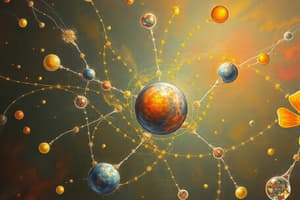Podcast
Questions and Answers
What is the atomic number of an atom and how is it determined?
What is the atomic number of an atom and how is it determined?
The atomic number of an atom is defined by the number of protons it has. It is determined by counting the number of protons in the nucleus of the atom.
What is the mass number of an atom and how is it calculated?
What is the mass number of an atom and how is it calculated?
The mass number of an atom is defined by the number of protons and neutrons it contains in its nucleus. It is calculated by adding the number of protons and neutrons together.
What is the symbol used to represent the atomic number of an element?
What is the symbol used to represent the atomic number of an element?
The atomic number of an element is represented with the symbol Z.
What are the three subatomic particles present in atoms?
What are the three subatomic particles present in atoms?
What is the charge and atomic mass of a proton?
What is the charge and atomic mass of a proton?
What is the charge and atomic mass of an electron?
What is the charge and atomic mass of an electron?
What is the atomic number?
What is the atomic number?
How can the atomic number be found on the periodic table?
How can the atomic number be found on the periodic table?
What is the mass number?
What is the mass number?
What is the formula for mass number?
What is the formula for mass number?
What are isotopes?
What are isotopes?
How can the mass number of an atom be determined?
How can the mass number of an atom be determined?
What is the relationship between atomic number and mass number?
What is the relationship between atomic number and mass number?
How can one calculate the number of neutrons in an atom?
How can one calculate the number of neutrons in an atom?
What is the difference between atomic number and mass number?
What is the difference between atomic number and mass number?
How can one determine the mass number of an atom?
How can one determine the mass number of an atom?
What are isobars?
What are isobars?
What is the difference between mass number and atomic mass?
What is the difference between mass number and atomic mass?
What is the atomic mass of carbon?
What is the atomic mass of carbon?
Where can the atomic mass of an element be found?
Where can the atomic mass of an element be found?
Flashcards are hidden until you start studying
Study Notes
Atomic Number and Determination
- The atomic number represents the number of protons in an atom's nucleus.
- It uniquely identifies an element and determines its position on the periodic table.
- Found directly on the periodic table, usually as a whole number above the element symbol.
Mass Number and Calculation
- The mass number is the total count of protons and neutrons in an atom's nucleus.
- Calculated using the formula: Mass Number = Number of Protons + Number of Neutrons.
Symbol for Atomic Number
- The symbol used to represent the atomic number is "Z".
Subatomic Particles
- The three subatomic particles present in atoms are protons, neutrons, and electrons.
Protons: Charge and Atomic Mass
- Protons carry a positive charge (+1) and have an approximate atomic mass of 1 atomic mass unit (amu).
Electrons: Charge and Atomic Mass
- Electrons possess a negative charge (-1) and have a negligible atomic mass, approximately 1/1836 of a proton.
Isotopes
- Isotopes are variants of the same element that have the same number of protons but different numbers of neutrons, leading to different mass numbers.
Determining Mass Number
- The mass number of an atom is determined by adding its number of protons and neutrons.
Relationship Between Atomic Number and Mass Number
- The atomic number indicates the element's identity, while the mass number provides information about the isotope of that element.
Calculating Neutrons
- The number of neutrons in an atom is calculated as: Number of Neutrons = Mass Number - Atomic Number.
Difference Between Atomic Number and Mass Number
- Atomic number (Z) identifies an element and equals the number of protons, whereas mass number represents the total number of protons and neutrons.
Isobars
- Isobars are atoms of different elements that have the same mass number but different atomic numbers.
Mass Number vs. Atomic Mass
- Mass number is a whole number representing the count of nucleons, while atomic mass is a weighted average of isotopes' masses, often not a whole number.
Atomic Mass of Carbon
- The atomic mass of carbon is approximately 12.01 amu.
Finding Atomic Mass of an Element
- The atomic mass can be found in the periodic table, typically below the element symbol.
Studying That Suits You
Use AI to generate personalized quizzes and flashcards to suit your learning preferences.




